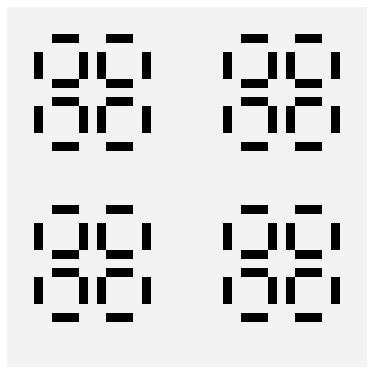Basic Usage¶
This notebook illustrates some of the basic features of Seagull. Most of these are just animated outputs found in the Documentation. If you wish to add more examples, please create a Jupyter notebook and open up a Pull Request!
[1]:
# Some settings to show a JS animation
import matplotlib.pyplot as plt
plt.rcParams["animation.html"] = "jshtml"
[2]:
import seagull as sg
import seagull.lifeforms as lf
Simple Pulsars¶
In this example, we’ll create four (4) Pulsars in a 40x40 board.
[3]:
# Initialize board
board = sg.Board(size=(40,40))
# Add three Pulsar lifeforms in various locations
board.add(lf.Pulsar(), loc=(1,1))
board.add(lf.Pulsar(), loc=(1,22))
board.add(lf.Pulsar(), loc=(20,1))
board.add(lf.Pulsar(), loc=(20,22))
The view command allows us to see the current state of the Board
[4]:
board.view()
[4]:
(<Figure size 360x360 with 1 Axes>,
<matplotlib.image.AxesImage at 0x7f8eef2932d0>)

Running the simulation returns a set of statistics that characterizes your run:
[5]:
# Simulate board
sim = sg.Simulator(board)
sim.run(sg.rules.conway_classic, iters=100)
2020-11-21 05:39:52.199 | INFO | seagull.simulator:compute_statistics:128 - Computing simulation statistics...
[5]:
{'peak_cell_coverage': 0.18,
'avg_cell_coverage': 0.1463366336633663,
'avg_shannon_entropy': 3.0217796046186556,
'peak_shannon_entropy': 3.2433182601909962}
The animation command returns a matplotlib.FuncAnimation that you can use to show or save your animation. Note that sometimes, saving to GIF or MP4 might require other dependencies such as ffmpeg or ImageMagick. For more information, please check this blog post.
[6]:
%%capture
anim = sim.animate()
2020-11-21 05:39:52.222 | INFO | seagull.simulator:animate:183 - Rendering animation...
[7]:
anim
[7]:
Small ecosystem¶
In this example, we’ll demonstrate the diversity of our Lifeforms and see how they interact with one another!
[8]:
board = sg.Board(size=(30,30))
board.add(lf.Glider(), loc=(4,4))
board.add(lf.Glider(), loc=(10,4))
board.add(lf.Glider(), loc=(15,4))
board.add(lf.Pulsar(), loc=(5,12))
board.add(lf.Blinker(length=3), loc=(22,4))
board.add(lf.Blinker(length=3), loc=(22,8))
[9]:
%%capture
# Simulate board
sim = sg.Simulator(board)
stats = sim.run(sg.rules.conway_classic, iters=100)
anim = sim.animate()
2020-11-21 05:39:55.380 | INFO | seagull.simulator:compute_statistics:128 - Computing simulation statistics...
2020-11-21 05:39:55.391 | INFO | seagull.simulator:animate:183 - Rendering animation...
[10]:
anim
[10]:
Custom lifeform¶
Lastly, we’ll create our very first custom lifeform! Defining it is just the same as instantiating any other pre-made lifeform. However in this example, we’ll save the instance in a variable custom_lf so that we can place it easily without writing the whole matrix again and again.
[11]:
board = sg.Board(size=(30,30))
# Our custom lifeform
custom_lf = lf.Custom([[0, 0, 1, 1, 0],
[1, 1, 0, 1, 1],
[1, 1, 1, 1, 0],
[0, 1, 1, 0, 0]])
board.add(custom_lf, loc=(1,1))
board.add(custom_lf, loc=(10,1))
board.add(custom_lf, loc=(20,1))
board.add(custom_lf, loc=(5, 10))
board.add(custom_lf, loc=(15, 10))
board.add(custom_lf, loc=(10, 20))
[12]:
%%capture
sim = sg.Simulator(board)
stats = sim.run(sg.rules.conway_classic, iters=100)
anim = sim.animate()
2020-11-21 05:39:58.575 | INFO | seagull.simulator:compute_statistics:128 - Computing simulation statistics...
2020-11-21 05:39:58.585 | INFO | seagull.simulator:animate:183 - Rendering animation...
[13]:
anim
[13]:

